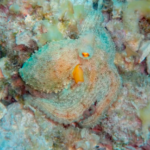Report, Octopus inspired stretchable surfaces with programmable 3D texture morphing for synthetic camouflaging skins
Technologies that use stretchable materials are increasingly important, yet we are unable to control how they stretch with much more sophistication than inflating balloons. Nature, however, demonstrates remarkable control of stretchable surfaces; for example, cephalopods can project hierarchical structures from their skin in milliseconds for a wide range of textural camouflage. Inspired by cephalopod muscular morphology, we developed synthetic tissue groupings that allowed the programmable transformation of two-dimensional (2D) stretchable surfaces into target 3D shapes. The synthetic tissue groupings consisted of elastomeric membranes embedded with inextensible textile mesh that inflated to within 10% of their target shapes by using a simple fabrication method and modeling approach. These stretchable surfaces transform from flat sheets to 3D textures that imitate natural stone and plant shapes and camouflage into their background environments.
Learn about our two Decals!
 Click here to find out more about our Fall Bioinspired Design Decal and our Spring Bioinspired Design in Action Decal – ALL MAJORS are welcome.
Click here to find out more about our Fall Bioinspired Design Decal and our Spring Bioinspired Design in Action Decal – ALL MAJORS are welcome.Berkeley BioDesign Community
 Click here to learn about the BioD: Bio-Inspired Design @ Berkeley student organization or here to signup for more info.
Click here to learn about the BioD: Bio-Inspired Design @ Berkeley student organization or here to signup for more info.Search
Student Login





I imagine that the neurological circuits underlying these processes are governed by both 2d spacing maps with their brains as…
to reduce the impact of car accidents, it may be possible to study the force diverting physics of cockroaches to…
you see this type of head-bobbing stability in many avian creatures related to pigeons like chickens. the head ability to…
not like they taught horses how to run! this is an example of convergent evolution where both sea creatures and…
The brain functions in a similar way with neuronal connections. our brains are able to utilize the multiplicity of connections…